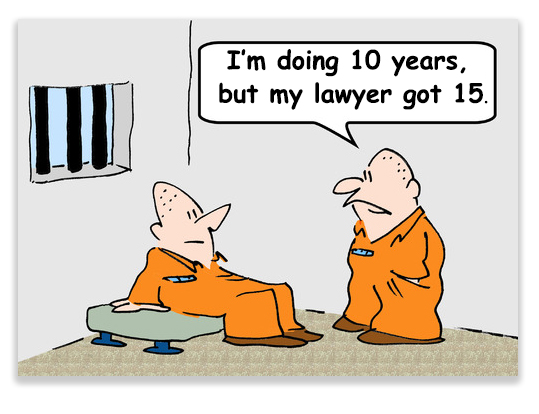We post news and comment on federal criminal justice issues, focused primarily on trial and post-conviction matters, legislative initiatives, and sentencing issues.

A COUPLE OF CAUTIONARY 2255 DECISIONS
A pair of Circuit decisions on 28 U.S.C. § 2255 motions last week did not deliver a lot of hope to petitioners.
 In one 6th Circuit decision, former Cuyahoga County Commissioner Jimmy Dimora got a number of bribery-related convictions vacated because of the intervening 2016 Supreme Court decision in McDonnell v. United States. The decision is instructive for public officials and employees caught up in so-called pay-to-play cases, where they are accused of trading official favors for profit. But the cautionary note for the rest of § 2255 movants relates to cumulative error.
In one 6th Circuit decision, former Cuyahoga County Commissioner Jimmy Dimora got a number of bribery-related convictions vacated because of the intervening 2016 Supreme Court decision in McDonnell v. United States. The decision is instructive for public officials and employees caught up in so-called pay-to-play cases, where they are accused of trading official favors for profit. But the cautionary note for the rest of § 2255 movants relates to cumulative error.
Jimmy, like many § 2255 movants, argued that even if no single error he cited justified reversal, the cumulative effect of the many errors he cited was to violate his due process rights. “Cumulative error” is a favorite catch-all issue, added to the end of a § 2255 motion to give it sufficient heft.
Thehe cumulative error doctrine provides that an aggregation of errors that are in and of themselves insufficient to require a reversal can nevertheless yield a denial of a defendant’s 5th Amendment right to a fair trial, and thus – by the sheer weight of the pile of mistakes, require a mistrial.
As a circuit court of appeals observed in a case almost 30 years ago, “the possibility of cumulative error is often acknowledged but practically never found persuasive.” The doctrine justifies reversal only in the unusual case in which synergistic or repetitive error violates the defendant’s constitutional right to a fair trial.
The 6th Circuit poured additional cold water on the doctrine last week. The Circuit doubts that “cumulative error” has any place in a § 2255 motion: “We note, however, that we are uncertain whether this theory of prejudice is available to § 2255 petitioners… And we are especially uncertain that it is available where one of two claimed errors is an evidentiary error… But we leave these questions for the district court to consider on remand after it assesses the harmlessness of the instructional error independent of any cumulative effect.”
 Meanwhile, in the 5th Circuit, Lauro Valdez used a convenient handgun to shoot a man Lauro said was trying to break in. His self-defense claim might have worked, except that after Lauro shot him once, he walked over to the prostrate victim and pumped more three rounds into him.
Meanwhile, in the 5th Circuit, Lauro Valdez used a convenient handgun to shoot a man Lauro said was trying to break in. His self-defense claim might have worked, except that after Lauro shot him once, he walked over to the prostrate victim and pumped more three rounds into him.
An old lawyer I knew used to say, “Two bullets or two bodies, and you’ve got a problem.” That was Lauro’s predicament. He could explain the one shot at an intruder. The other three a minute later – not so easy.
Lauro was charged with being a felon-in-possession of a gun in violation of 18 USC § 922(g). His lawyer told him that he faced a 24-36 month Guidelines range if he were convicted. That was wrong, because USSG § 2K2.1(c)(1) has a cross-reference for murder – which clearly applied here – that would raise Lauro’s Guidelines to at least 324 months. That meant Lauro would undoubtedly get 10 years, the maximum sentence for felons-in-possession allowed by statute.
Being advised wrongly by his lawyer, Lauro figured he would use the “justification” defense at trial, arguing he had just grabbed a gun to protect himself from an imminent threat. This might have worked for him, too, except that on the eve of trial, he learned that his wife would testify the gun had been on Lauro’s nightstand a week before the shooting, way too long ago to let him argue a sudden need to possess a gun against an imminent threat.
Lauro decided to plead guilty. At the change-of-plea hearing, the judge explained that § 922(g) carried a 120-month statutory maximum, and that regardless of what his lawyer might have said about a possible sentence, “it’s not a guarantee and it’s not binding on this Court.”
Lauro, of course, agreed. Defendants in those hearings usually are able to process nothing the judge says, and Lauro was no exception.
At sentencing, the judge gave Lauro the full 10 years, using the Guidelines cross reference for murder. Lauro later claimed in his § 2255 motion that his lawyer had predicted only 36 months, and had said nothing about a murder cross-reference to the Guidelines.if he had known about the Guidelines’ murder cross-reference, Lauro wrote in his motion, he would not have waived his right to a jury trial. His lawyer admitted in an affidavit that he had completely missed the murder cross-reference when he advised Lauro.
 The issue when a defendant alleges his counsel’s errors led him to take a plea rather than go to trial is not whether the defendant could have won the trial, but instead only whether a rational defendant would have chosen to go to trial. Here, the 5th Circuit held Lauro’s lawyer’s performance was not deficient, because both he and the court told Juan about the 10-year statutory maximum. The Circuit so much as said that a competent lawyer can’t figure out the Guidelines, so misadvising his or her client was not deficient representation.
The issue when a defendant alleges his counsel’s errors led him to take a plea rather than go to trial is not whether the defendant could have won the trial, but instead only whether a rational defendant would have chosen to go to trial. Here, the 5th Circuit held Lauro’s lawyer’s performance was not deficient, because both he and the court told Juan about the 10-year statutory maximum. The Circuit so much as said that a competent lawyer can’t figure out the Guidelines, so misadvising his or her client was not deficient representation.
What’s more, the 5th said, Lauro suffered no prejudice, because it was clear that “rather than risking conviction by the jury (with no sentencing benefits whatsoever), Lauro hoped to parlay a late guilty plea into a credit for acceptance of responsibility and additional benefit from cooperating or rendering substantial assistance. In other words, knowing that wifey was going to blow up his defense, the Circuit said, Lauro did what any rational defendant would do.
One judge dissented, as he should have, from this terrible decision. Any rational defendant – being told that if he pled, he would get 120 months and if he went to trial, he would get 120 months – would take his chances with a jury.
Dimora v. United States, Case No. 18-4260, 2020 U.S. App. LEXIS 27675 (6th Cir Aug 31, 2020)
United States v. Valdez, Case No. 18-40495, 2020 U.S. App. LEXIS 27909 (5th Cir. Sep 1, 2020)
– Thomas L. Root

